Business Decision Making: Payback Period and NPV Analysis for A&B plc
VerifiedAdded on 2023/01/09
|7
|1320
|68
Essay
AI Summary
This essay analyzes business decision-making processes, focusing on the case of A&B plc, a restaurant chain evaluating potential investments in a dishwashing or software project. The essay begins with an introduction to business decision-making and then delves into the application of key capital budgeting techniques, including the payback period and net present value (NPV), to assess the viability of each project. Detailed calculations and comparisons are provided to determine which project offers a better return on investment. Furthermore, the essay explores the financial and non-financial factors that influence decision-making, such as ratio analysis, investment appraisal techniques, risk analysis, strong management teams, diversified human capital, and growth potential. The conclusion summarizes the findings, highlighting the importance of these tools in identifying the most profitable investment opportunities and emphasizing the significance of both financial and non-financial considerations in making sound business decisions.

Individual Essay
Paraphrase This Document
Need a fresh take? Get an instant paraphrase of this document with our AI Paraphraser
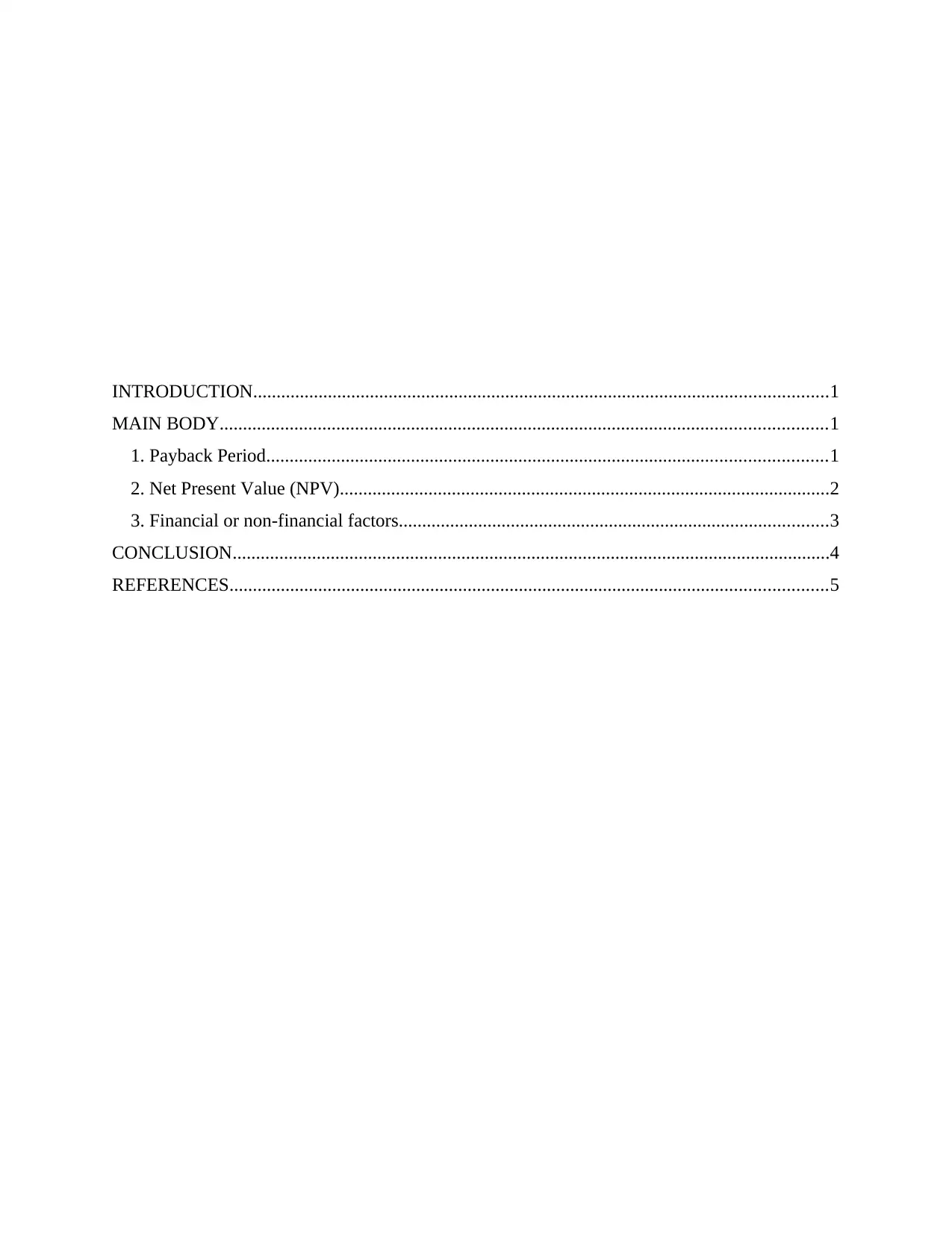
INTRODUCTION...........................................................................................................................1
MAIN BODY..................................................................................................................................1
1. Payback Period........................................................................................................................1
2. Net Present Value (NPV).........................................................................................................2
3. Financial or non-financial factors............................................................................................3
CONCLUSION................................................................................................................................4
REFERENCES................................................................................................................................5
MAIN BODY..................................................................................................................................1
1. Payback Period........................................................................................................................1
2. Net Present Value (NPV).........................................................................................................2
3. Financial or non-financial factors............................................................................................3
CONCLUSION................................................................................................................................4
REFERENCES................................................................................................................................5
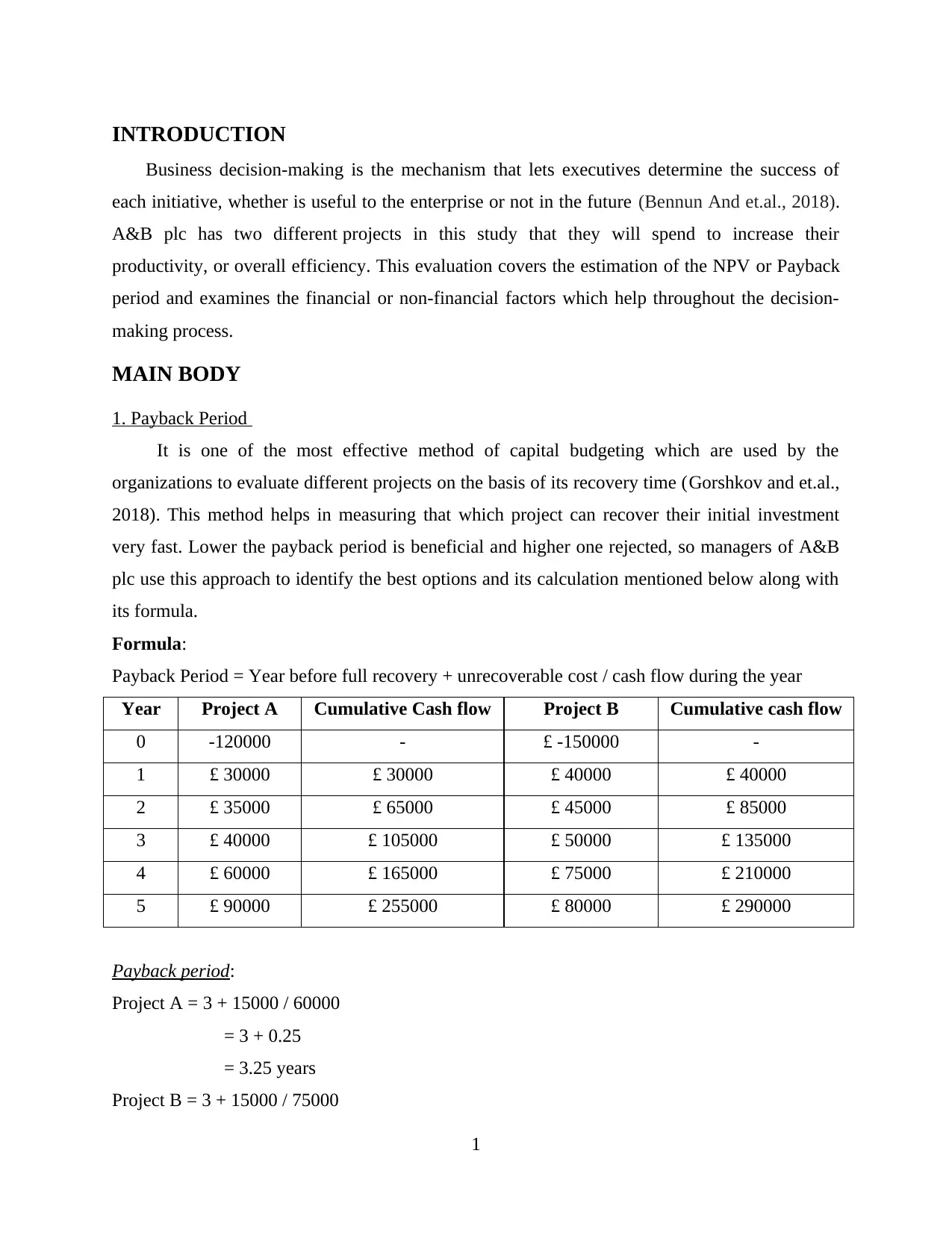
INTRODUCTION
Business decision-making is the mechanism that lets executives determine the success of
each initiative, whether is useful to the enterprise or not in the future (Bennun And et.al., 2018).
A&B plc has two different projects in this study that they will spend to increase their
productivity, or overall efficiency. This evaluation covers the estimation of the NPV or Payback
period and examines the financial or non-financial factors which help throughout the decision-
making process.
MAIN BODY
1. Payback Period
It is one of the most effective method of capital budgeting which are used by the
organizations to evaluate different projects on the basis of its recovery time (Gorshkov and et.al.,
2018). This method helps in measuring that which project can recover their initial investment
very fast. Lower the payback period is beneficial and higher one rejected, so managers of A&B
plc use this approach to identify the best options and its calculation mentioned below along with
its formula.
Formula:
Payback Period = Year before full recovery + unrecoverable cost / cash flow during the year
Year Project A Cumulative Cash flow Project B Cumulative cash flow
0 -120000 - £ -150000 -
1 £ 30000 £ 30000 £ 40000 £ 40000
2 £ 35000 £ 65000 £ 45000 £ 85000
3 £ 40000 £ 105000 £ 50000 £ 135000
4 £ 60000 £ 165000 £ 75000 £ 210000
5 £ 90000 £ 255000 £ 80000 £ 290000
Payback period:
Project A = 3 + 15000 / 60000
= 3 + 0.25
= 3.25 years
Project B = 3 + 15000 / 75000
1
Business decision-making is the mechanism that lets executives determine the success of
each initiative, whether is useful to the enterprise or not in the future (Bennun And et.al., 2018).
A&B plc has two different projects in this study that they will spend to increase their
productivity, or overall efficiency. This evaluation covers the estimation of the NPV or Payback
period and examines the financial or non-financial factors which help throughout the decision-
making process.
MAIN BODY
1. Payback Period
It is one of the most effective method of capital budgeting which are used by the
organizations to evaluate different projects on the basis of its recovery time (Gorshkov and et.al.,
2018). This method helps in measuring that which project can recover their initial investment
very fast. Lower the payback period is beneficial and higher one rejected, so managers of A&B
plc use this approach to identify the best options and its calculation mentioned below along with
its formula.
Formula:
Payback Period = Year before full recovery + unrecoverable cost / cash flow during the year
Year Project A Cumulative Cash flow Project B Cumulative cash flow
0 -120000 - £ -150000 -
1 £ 30000 £ 30000 £ 40000 £ 40000
2 £ 35000 £ 65000 £ 45000 £ 85000
3 £ 40000 £ 105000 £ 50000 £ 135000
4 £ 60000 £ 165000 £ 75000 £ 210000
5 £ 90000 £ 255000 £ 80000 £ 290000
Payback period:
Project A = 3 + 15000 / 60000
= 3 + 0.25
= 3.25 years
Project B = 3 + 15000 / 75000
1
⊘ This is a preview!⊘
Do you want full access?
Subscribe today to unlock all pages.

Trusted by 1+ million students worldwide
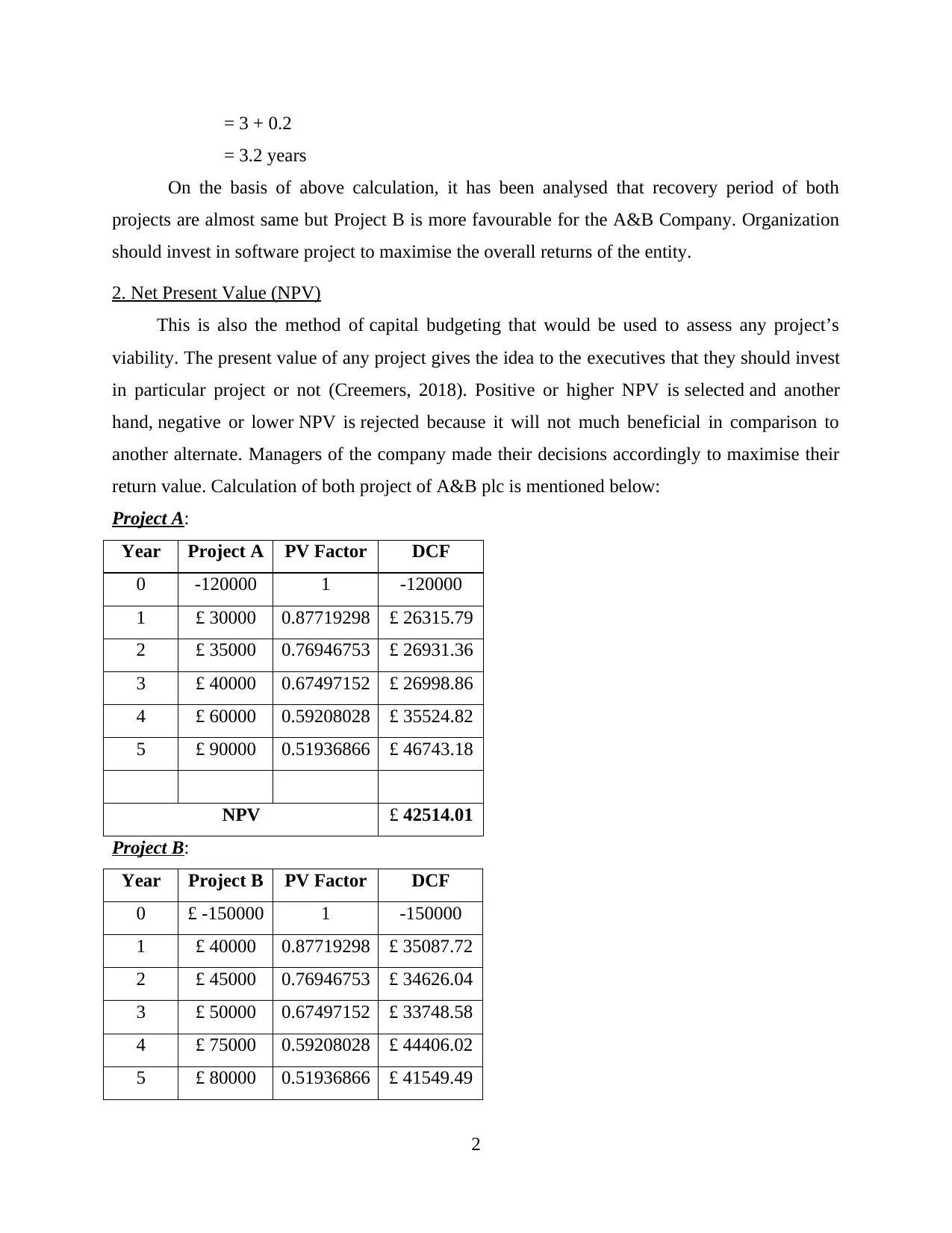
= 3 + 0.2
= 3.2 years
On the basis of above calculation, it has been analysed that recovery period of both
projects are almost same but Project B is more favourable for the A&B Company. Organization
should invest in software project to maximise the overall returns of the entity.
2. Net Present Value (NPV)
This is also the method of capital budgeting that would be used to assess any project’s
viability. The present value of any project gives the idea to the executives that they should invest
in particular project or not (Creemers, 2018). Positive or higher NPV is selected and another
hand, negative or lower NPV is rejected because it will not much beneficial in comparison to
another alternate. Managers of the company made their decisions accordingly to maximise their
return value. Calculation of both project of A&B plc is mentioned below:
Project A:
Year Project A PV Factor DCF
0 -120000 1 -120000
1 £ 30000 0.87719298 £ 26315.79
2 £ 35000 0.76946753 £ 26931.36
3 £ 40000 0.67497152 £ 26998.86
4 £ 60000 0.59208028 £ 35524.82
5 £ 90000 0.51936866 £ 46743.18
NPV £ 42514.01
Project B:
Year Project B PV Factor DCF
0 £ -150000 1 -150000
1 £ 40000 0.87719298 £ 35087.72
2 £ 45000 0.76946753 £ 34626.04
3 £ 50000 0.67497152 £ 33748.58
4 £ 75000 0.59208028 £ 44406.02
5 £ 80000 0.51936866 £ 41549.49
2
= 3.2 years
On the basis of above calculation, it has been analysed that recovery period of both
projects are almost same but Project B is more favourable for the A&B Company. Organization
should invest in software project to maximise the overall returns of the entity.
2. Net Present Value (NPV)
This is also the method of capital budgeting that would be used to assess any project’s
viability. The present value of any project gives the idea to the executives that they should invest
in particular project or not (Creemers, 2018). Positive or higher NPV is selected and another
hand, negative or lower NPV is rejected because it will not much beneficial in comparison to
another alternate. Managers of the company made their decisions accordingly to maximise their
return value. Calculation of both project of A&B plc is mentioned below:
Project A:
Year Project A PV Factor DCF
0 -120000 1 -120000
1 £ 30000 0.87719298 £ 26315.79
2 £ 35000 0.76946753 £ 26931.36
3 £ 40000 0.67497152 £ 26998.86
4 £ 60000 0.59208028 £ 35524.82
5 £ 90000 0.51936866 £ 46743.18
NPV £ 42514.01
Project B:
Year Project B PV Factor DCF
0 £ -150000 1 -150000
1 £ 40000 0.87719298 £ 35087.72
2 £ 45000 0.76946753 £ 34626.04
3 £ 50000 0.67497152 £ 33748.58
4 £ 75000 0.59208028 £ 44406.02
5 £ 80000 0.51936866 £ 41549.49
2
Paraphrase This Document
Need a fresh take? Get an instant paraphrase of this document with our AI Paraphraser
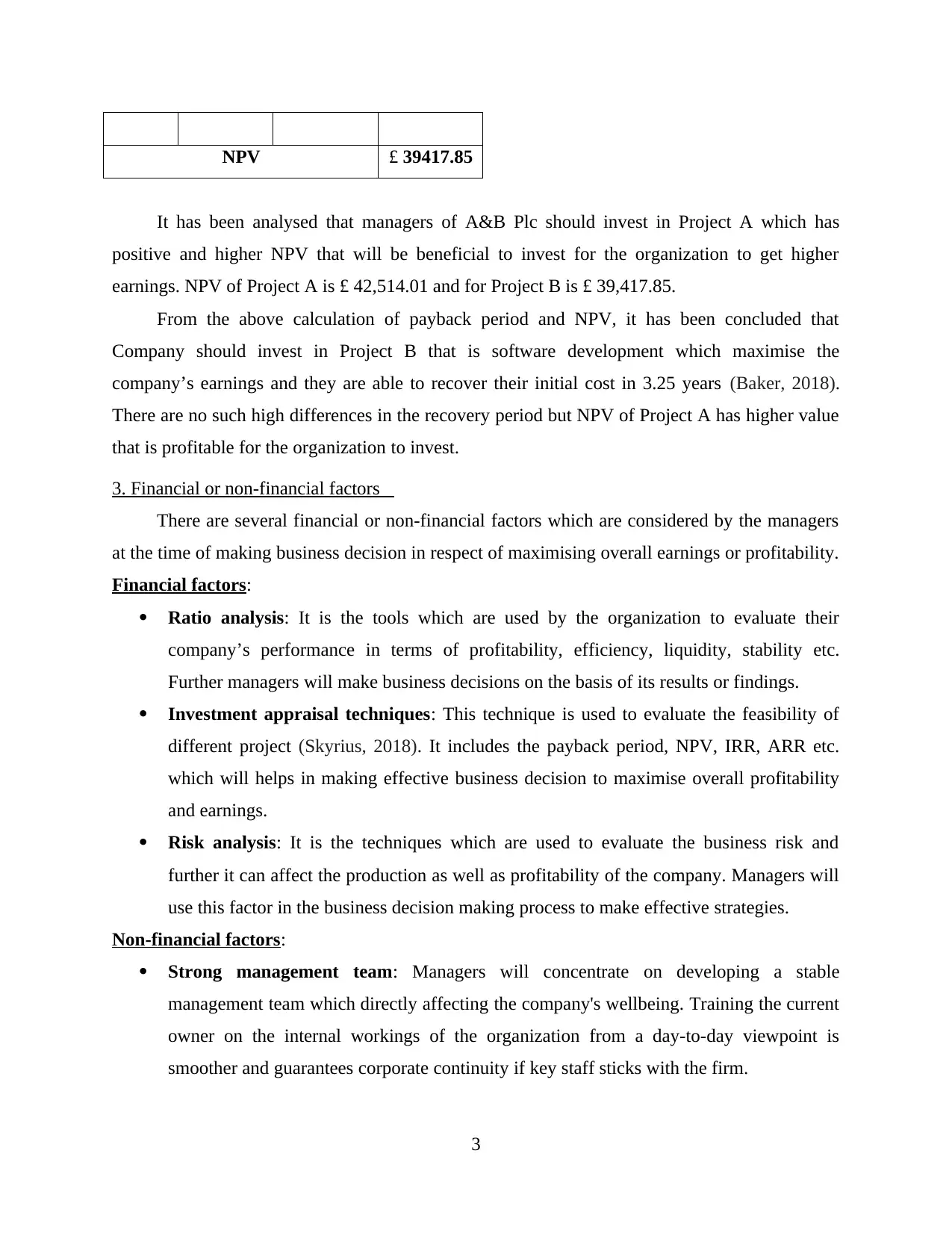
NPV £ 39417.85
It has been analysed that managers of A&B Plc should invest in Project A which has
positive and higher NPV that will be beneficial to invest for the organization to get higher
earnings. NPV of Project A is £ 42,514.01 and for Project B is £ 39,417.85.
From the above calculation of payback period and NPV, it has been concluded that
Company should invest in Project B that is software development which maximise the
company’s earnings and they are able to recover their initial cost in 3.25 years (Baker, 2018).
There are no such high differences in the recovery period but NPV of Project A has higher value
that is profitable for the organization to invest.
3. Financial or non-financial factors
There are several financial or non-financial factors which are considered by the managers
at the time of making business decision in respect of maximising overall earnings or profitability.
Financial factors:
Ratio analysis: It is the tools which are used by the organization to evaluate their
company’s performance in terms of profitability, efficiency, liquidity, stability etc.
Further managers will make business decisions on the basis of its results or findings.
Investment appraisal techniques: This technique is used to evaluate the feasibility of
different project (Skyrius, 2018). It includes the payback period, NPV, IRR, ARR etc.
which will helps in making effective business decision to maximise overall profitability
and earnings.
Risk analysis: It is the techniques which are used to evaluate the business risk and
further it can affect the production as well as profitability of the company. Managers will
use this factor in the business decision making process to make effective strategies.
Non-financial factors:
Strong management team: Managers will concentrate on developing a stable
management team which directly affecting the company's wellbeing. Training the current
owner on the internal workings of the organization from a day-to-day viewpoint is
smoother and guarantees corporate continuity if key staff sticks with the firm.
3
It has been analysed that managers of A&B Plc should invest in Project A which has
positive and higher NPV that will be beneficial to invest for the organization to get higher
earnings. NPV of Project A is £ 42,514.01 and for Project B is £ 39,417.85.
From the above calculation of payback period and NPV, it has been concluded that
Company should invest in Project B that is software development which maximise the
company’s earnings and they are able to recover their initial cost in 3.25 years (Baker, 2018).
There are no such high differences in the recovery period but NPV of Project A has higher value
that is profitable for the organization to invest.
3. Financial or non-financial factors
There are several financial or non-financial factors which are considered by the managers
at the time of making business decision in respect of maximising overall earnings or profitability.
Financial factors:
Ratio analysis: It is the tools which are used by the organization to evaluate their
company’s performance in terms of profitability, efficiency, liquidity, stability etc.
Further managers will make business decisions on the basis of its results or findings.
Investment appraisal techniques: This technique is used to evaluate the feasibility of
different project (Skyrius, 2018). It includes the payback period, NPV, IRR, ARR etc.
which will helps in making effective business decision to maximise overall profitability
and earnings.
Risk analysis: It is the techniques which are used to evaluate the business risk and
further it can affect the production as well as profitability of the company. Managers will
use this factor in the business decision making process to make effective strategies.
Non-financial factors:
Strong management team: Managers will concentrate on developing a stable
management team which directly affecting the company's wellbeing. Training the current
owner on the internal workings of the organization from a day-to-day viewpoint is
smoother and guarantees corporate continuity if key staff sticks with the firm.
3

Diversified human capital risk: When a corporation depends on a particular client, staff,
or manufacturer, it may be similarly harmful (Tseng, Chiu and Liang, 2018).
For example, if a single customer contributes more than twice of an owner’s profits; the
owner becomes more of a company owner than a supplier. If a customer stops using the
services of the company for whatever reason, it poses a great risk.
Growth potential for customers, products and market: Potential customers or
consumers would like to see a consistent strategic plan growth strategy which involving
consumer base development, regions and possibly even goods. Then, they get to see if
revenue and the bottom line can affect that.
CONCLUSION
Based on the findings it was observed that the business decision making is an essential for
the entireties. A variety of investment assessment approaches seem to exist which allow the
company identify the correct opportunities to raise its earnings through spending in right project.
Net present profit or payback period is the most efficient technique which managers adopt to
assess a project's operating feasibility. It has several financial advantages that managers would
need to recognize before implementing it.
4
or manufacturer, it may be similarly harmful (Tseng, Chiu and Liang, 2018).
For example, if a single customer contributes more than twice of an owner’s profits; the
owner becomes more of a company owner than a supplier. If a customer stops using the
services of the company for whatever reason, it poses a great risk.
Growth potential for customers, products and market: Potential customers or
consumers would like to see a consistent strategic plan growth strategy which involving
consumer base development, regions and possibly even goods. Then, they get to see if
revenue and the bottom line can affect that.
CONCLUSION
Based on the findings it was observed that the business decision making is an essential for
the entireties. A variety of investment assessment approaches seem to exist which allow the
company identify the correct opportunities to raise its earnings through spending in right project.
Net present profit or payback period is the most efficient technique which managers adopt to
assess a project's operating feasibility. It has several financial advantages that managers would
need to recognize before implementing it.
4
⊘ This is a preview!⊘
Do you want full access?
Subscribe today to unlock all pages.

Trusted by 1+ million students worldwide
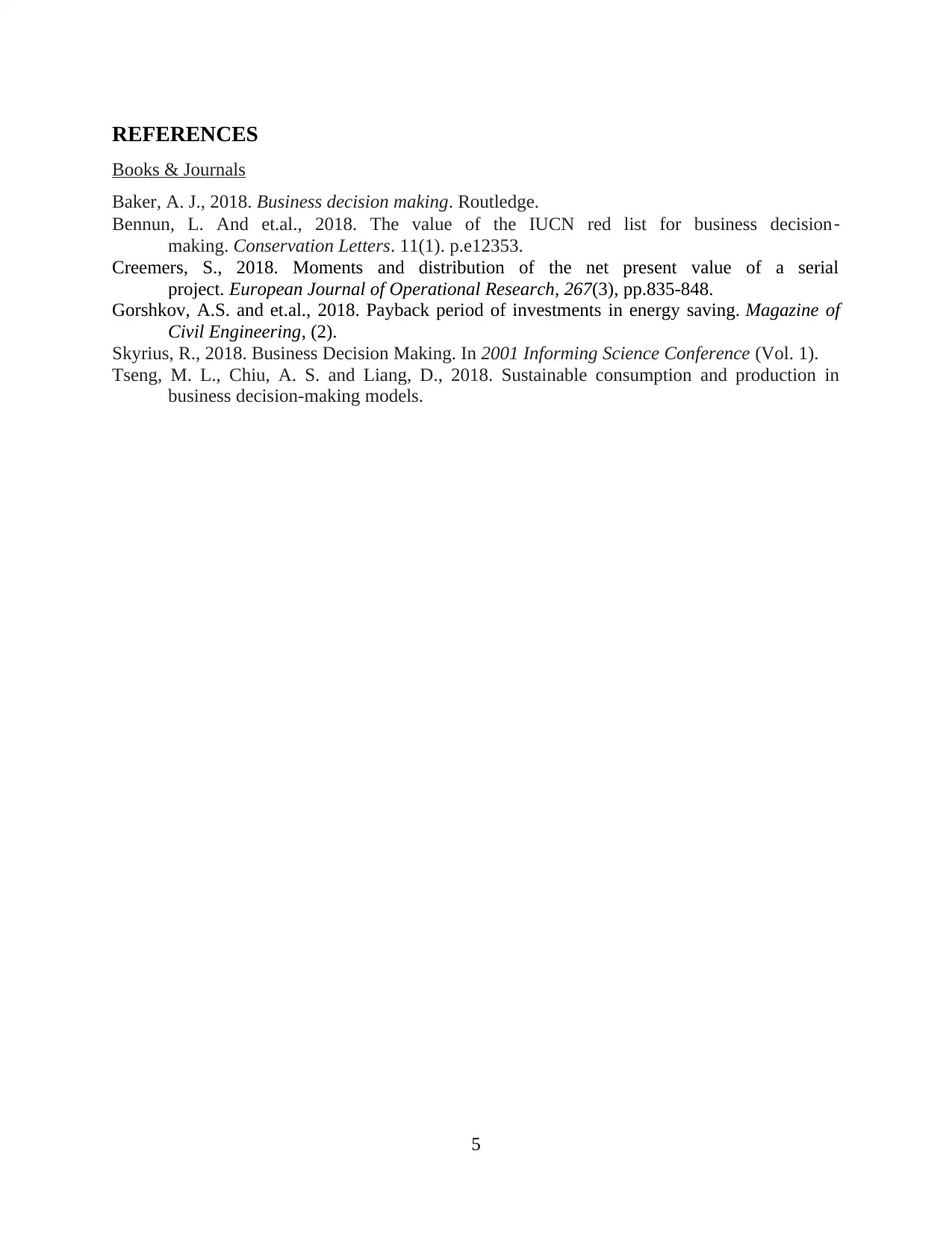
REFERENCES
Books & Journals
Baker, A. J., 2018. Business decision making. Routledge.
Bennun, L. And et.al., 2018. The value of the IUCN red list for business decision‐
making. Conservation Letters. 11(1). p.e12353.
Creemers, S., 2018. Moments and distribution of the net present value of a serial
project. European Journal of Operational Research, 267(3), pp.835-848.
Gorshkov, A.S. and et.al., 2018. Payback period of investments in energy saving. Magazine of
Civil Engineering, (2).
Skyrius, R., 2018. Business Decision Making. In 2001 Informing Science Conference (Vol. 1).
Tseng, M. L., Chiu, A. S. and Liang, D., 2018. Sustainable consumption and production in
business decision-making models.
5
Books & Journals
Baker, A. J., 2018. Business decision making. Routledge.
Bennun, L. And et.al., 2018. The value of the IUCN red list for business decision‐
making. Conservation Letters. 11(1). p.e12353.
Creemers, S., 2018. Moments and distribution of the net present value of a serial
project. European Journal of Operational Research, 267(3), pp.835-848.
Gorshkov, A.S. and et.al., 2018. Payback period of investments in energy saving. Magazine of
Civil Engineering, (2).
Skyrius, R., 2018. Business Decision Making. In 2001 Informing Science Conference (Vol. 1).
Tseng, M. L., Chiu, A. S. and Liang, D., 2018. Sustainable consumption and production in
business decision-making models.
5
1 out of 7
Related Documents
Your All-in-One AI-Powered Toolkit for Academic Success.
+13062052269
info@desklib.com
Available 24*7 on WhatsApp / Email
![[object Object]](/_next/static/media/star-bottom.7253800d.svg)
Unlock your academic potential
© 2024 | Zucol Services PVT LTD | All rights reserved.





